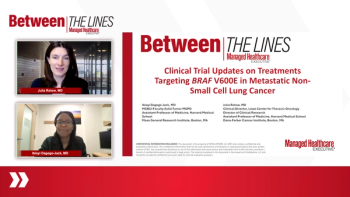Barriers to Adequate Testing for MDR HIV and Treatment Optimization
Treatment barriers inhibit optimal care for many patients diagnosed with HIV.
Episodes in this series
Eugene McCray, M.D.: Some patients, because they have not been adequately educated about resistance testing and what it means, and how it could benefit them, are very reluctant to have it done because they know the results are shared with others and with the public health system. Just for your information, it’s required that health departments or doctors when a laboratory does viral resistance testing, those results are reported to public health. They go to the local health department, and that local or state health department will often share the data with the CDC [Centers for Disease Control and Prevention]. So, patients are reluctant to get viral load testing if they know their results are going to be shared with public health.
That has to do, in some instances, with outdated legislation that exists in some states and some counties that criminalizes HIV [human immunodeficiency virus]. So, if you’re a person with HIV, and you have sex with someone and don’t inform them of your status and use appropriate precautions, you can be charged with a crime even if you don’t transmit the infection. There are some patients in the community who think those results can be used to charge them with a crime, especially if they are having sex with folks and not disclosing their status.
One of the things that is being done now, there’s a lot of education occurring with state and local health departments and with people living with HIV, and HIV advocates and others, to help patients understand why viral resistance testing is important, and how important it is to have those results reported. This is so we can monitor trends over time and make adjustments to initial therapy in people who are naive, who may have had a resistant strain of the virus transmitted to them.
It’s a challenge here in the South of the United States where we have a lot of HIV criminalization laws on the books that are outdated, and there’s a huge effort now at various levels to try to get the legislation changed.
Optimizing HIV therapy is important, and to do that you have to keep long-term treatment success in mind because that’s the key to optimizing HIV treatment and care. To do that, it’s important to address the concerns your patients may have about their treatment regimen. And those concerns can be many. I think some of the most common concerns are the difficulties patients may have taking multiple pills a day. As you know, ART [antiretroviral therapy] regimens can vary in pill burden and should be tailored for the individual patient’s medical situation, so they can enhance their adherence and support treatment success. Another concern patients often have is about side effects from some of the ART regimens. So, it’s important to make sure they understand what those side effects are so they’re not surprised when they have them, and to put them on drugs that have fewer side effects because there are many good options available now.
Then, the other concern I think patients have and often don’t talk about is the difficulty they may have adhering to the medication. That may be due to a number of reasons. They might not understand the dosing instructions because they weren’t explained to them carefully, or if they were explained to them, it was done at a time when they were still trying to accept the fact that they are HIV positive, so they didn’t hear a thing you were saying. Then you need to make sure the regimen is not too complex, which can be another reason for poor adherence. Also, missed doses due to eating and drinking requirements with some of the medications could be a factor. There are some medicines you have to take with food, and there are some medicines you have to take on an empty stomach. So, understanding what the patient’s situation is and making sure their medication is consistent with their needs. Then finally, there can be difficulty refilling medication due to cost. It involves making sure you understand that and then working with social services and others to make sure patients are able to get their medication when it’s time for them to refill them, etc.
Housing, as I mentioned, is probably the strongest predictor both for people acquiring the HIV infection and for people not staying on their medication and developing drug resistance and subsequently multiple drug resistance. I think having some of these funds go to support increased housing programs for people living with and at risk for acquiring HIV is important and I think could have a big impact. The other big area where I think there are not enough investments and these funds could help tremendously is in mental health and substance abuse treatment and prevention. There’s a federal agency called the Substance Abuse and Mental Health Services Administration that is only peripherally involved in HIV care, and they should be more directly involved and have more funding to help address these issues in people with HIV and at risk for HIV.
The third area I think would be working with communities, and local areas to support programs to address some of the structural barriers that are affecting people’s ability to access health care. These are things like health care staffing shortages. Nobody ever talks about that, and that’s a huge problem. There are stigma and biases that exist among the medical community, so making sure there are strong programs to work with health care providers and paraprofessionals so we can address some of the biases they may have. Then there’s the whole issue of transportation. That’s another big structural barrier, especially in rural areas and some urban areas.
Then the last one I thought about was, there’s not much investment in rural health. So, increasing services in rural areas and communities where people are at risk for acquiring HIV and at high risk for falling out of HIV care.
Transcript edited for clarity.
Newsletter
Get the latest industry news, event updates, and more from Managed healthcare Executive.

























































